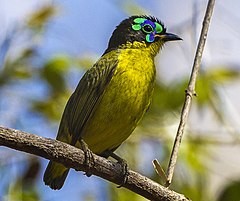Philepitta
Philepitta – rodzaj ptaków z rodziny brodawników (Philepittidae).
| Philepitta | |||
| I. Geoffroy Saint-Hilaire, 1838[1] | |||
 Przedstawiciel rodzaju – brodawnik żółtobrzuchy (P. schlegeli) | |||
| Systematyka | |||
| Domena | |||
|---|---|---|---|
| Królestwo | |||
| Typ | |||
| Podtyp | |||
| Gromada | |||
| Podgromada | |||
| Infragromada | |||
| Rząd | |||
| Podrząd | |||
| Rodzina | |||
| Rodzaj |
Philepitta | ||
| Typ nomenklatoryczny | |||
|
Philepitta sericea I. Geoffroy Saint-Hilaire, 1838 (= Turdus castaneus Statius Müller, 1776) | |||
| Synonimy | |||
|
| |||
| Gatunki | |||
| |||
Zasięg występowania edytuj
Rodzaj obejmuje gatunki występujące endemicznie na Madagaskarze[6].
Morfologia edytuj
Długość ciała 12,5–16,5 cm[6].
Systematyka edytuj
Etymologia edytuj
- Philepitta (Philopitta): zbitka wyrazowa nazw rodzajów: Philedon Cuvier, 1817 (filemon) oraz Pitta Vieillot, 1816 (kurtaczek)[7].
- Brissonia: Mathurin Jacques Brisson (1723–1806), francuski ornitolog[8]. Gatunek typowy: Turdus nigerrimus J.F. Gmelin, 1789 (= Turdus castaneus Statius Müller, 1776).
- Buddinghia: Cornelia Schlegel z domu Buddingh (1815–1864), pierwsza, holenderska żona niemieckiego ornitologa prof. Hermanna Schlegla[9]. Gatunek typowy: Philepitta schlegeli Schlegel, 1867.
- Paictes: gr. παικτης paiktēs „tancerz, aktor”, od παιζω paizō „grać”[10].
Podział systematyczny edytuj
Do rodzaju należą następujące gatunki[11]:
- Philepitta castanea (Statius Müller, 1776) – brodawnik aksamitny
- Philepitta schlegeli Schlegel, 1867 – brodawnik żółtobrzuchy
Uwagi edytuj
Przypisy edytuj
- ↑ I. Geoffroy Saint-Hilaire. Notice sur trois nouveaux generes d’oiseaux de Madagascar. „Comptes Rendus Hebdomadaires des Séances de l’Académie des Sciences”. 6, s. 440, 1838. (fr.).
- ↑ Ch.L. Bonaparte. Conspectus systematis ornithologie. „Annales des Sciences Naturelles, Zoologie”. Quatrième Série. 1, s. 123, 1854. (fr.).
- ↑ G. Hartlaub. Systematische Uebersicht der Vögel Madagascars. „Journal für Ornithologie”. 8 (43), s. 96, 1860. (niem.).
- ↑ H. Schlegel & F.P.L. Pollen: Mammifères et oiseaux. W: F.P.L. Pollen & D.C. von Dam: Recherches sur la faune de Madagascar et de ses dépendances. Cz. 2. Leyde: J.K. Steenhoff, 1868, s. 88. (fr.).
- ↑ C.J. Sundevall: Methodi naturalis avium disponendarum tentamen: försök till fogelklassens naturenliga uppställnung. Stockholm: Samson & Wallin, 1873, s. 63. (łac.).
- ↑ a b D.W. Winkler, S.M. Billerman & I.J. Lovette: Asities (Philepittidae), version 1.0. W: S.M. Billerman, B.K. Keeney, P.G. Rodewald & T.S. Schulenberg (red.): Birds of the World. Ithaca, NY: Cornell Lab of Ornithology, 2020. DOI: 10.2173/bow.philep1.01. [dostęp 2020-10-26]. (ang.).
- ↑ The Key to Scientific Names ↓, Philepitta [dostęp 2023-01-18].
- ↑ The Key to Scientific Names ↓, Brissonia [dostęp 2023-01-18].
- ↑ The Key to Scientific Names ↓, Buddinghia [dostęp 2023-01-18].
- ↑ The Key to Scientific Names ↓, Paictes [dostęp 2023-01-18].
- ↑ Systematyka i nazwy polskie za: P. Mielczarek & M. Kuziemko: Rodzina: Philepittidae Sharpe, 1870 - brodawniki - Asities (wersja: 2020-12-24). [w:] Kompletna lista ptaków świata [on-line]. Instytut Nauk o Środowisku Uniwersytetu Jagiellońskiego. [dostęp 2021-07-26].
Bibliografia edytuj
- The Key to Scientific Names, J.A. Jobling (red.), [w:] Birds of the World, S.M. Billerman et al. (red.), Cornell Lab of Ornithology, Ithaca (ang.).